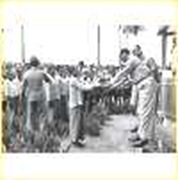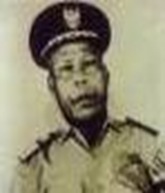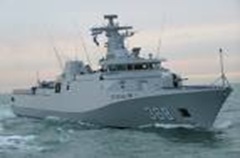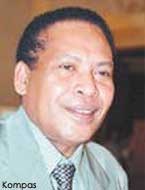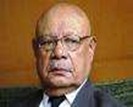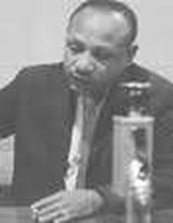By CELLY AKWAN
J.P.K. Van Eechoud (1904-1958)
Youwe’s political awareness was also the awareness, first of other coastal Papuans and then of Papuans in other parts of Dutch New Guinea. A Dutch government figure who had influenced him very much was J.P.K. Van Eechoud.
Police Officer and Sonica Officer
Van Eechoud was an experienced Dutch police officer, assigned at the Field Police Office in Manokwari, North Dutch New Guinea in 1936. In 1944, as recognition of his accomplishments as intelligence officer for the allied troops, he was appointed as Commanding Officer of the Netherlands-Indies Civil Administration (Conica) in Hollandia.
The NICA (Netherlands-Indies Civil Administration) was born from a secret talk between General Douglas MacArthur and Dr. Huib van Mook, leader of the Dutch colonial government in Netherlands-Indies in exile, in Brisbane (Australia) on March 4, 1944. They came to an agreement that small teams of NICA would follow the invasion military; the teams were responsible for running the civilian government in areas liberated by the allied troops. The highest authority of the NICA was a Senior Officer NICA (Sonica); regional administrators under Sonica included Van Eechoud.
When the allied troops left Netherlands New Guinea, landed and attacked the Japanese on Morotai, an island in North Moluccas, on September 15, 1944 before they moved to the Philippines, they returned the first parts of Netherlands-Indies – Hollandia and Sarmi – to the Dutch. The Nica which lacked police, communication means, and was limited to the occupation areas left by the American military was not able to enforce its authority in other parts of Dutch New Guinea. There was anarchy in these areas. There were still Japanese soldiers roaming in the jungle and elsewhere. The absence of police made the Papuans take the law into their own hands: they hunted the Japanese, killed them, and took their swords. Occasionally, the “Japanese hunting” took the form of the old head-hunting raids.
Papua battalion, police school, and government school
To get the Papuans involved more or less regularly in the war activity, Van Eechoud, who had been promoted to Army Major, established the Papua Battalion in December 1944. Meant as a police corps during war time, they got some basic military training and served as reserve troops of the Royal Dutch-Indies Army. The battalion was assigned with the tasks of clearing liberated areas in Dutch New Guinea and was under the command of Van Eechoud. Early 1946 the Papua Battalion had its “barrack” near Lake Sentani, Hollandia. In April 1953, it totaled 397 soldiers. Shortly after his promotion as an army major, Van Eechoud established in Merauke, a town in the southern coast of Dutch New Guinea which during WW II was not occupied by the Japanese but by the American and later Australian military, a police school for training Papuans as police. The school was later moved to Hollandia in 1945.
Late 1944, Conica Van Eechoud decided to establish a dormitory for young Papuans in Kota Nica, Hollandia, at the north edge of Lake Sentani. The students at the dormitory were a combination of the last years of elementary schools and one year “crash training of government assistants”. The crash training included six months of theoretical lessons and six other months for practice at government posts. Before the war started in Netherlands New Guinea, there was only one Papuan government assistant.
The first course attendants included Nicolaas Youwe from Kayu Pulau. The school had more than 150 students, half of them later worked in the government and the rest found their jobs in business companies, health care, and education. The school angered the South Moluccans in Dutch New Guinea because they had always supplied their cadres for government services. Van Eechoud then made a breakthrough of this practice. At the inauguration of the school, he said about things that were unforgettable to the Papuan students. “In 1828 we came here,” he said, “and we have told you since then how things work. Nowadays you are called to take the government of this land in your own hands; on this day, the new Papua is born.” Then, the oldest course attendant (his name was not mentioned) came forward and said: “We give you the honorary title of Bapak Papua, father of this new Papua.”
What Van Eechoud was
J.P.K. Van Eechoud handing out a present to a Papuan
No other Dutch government officials were given such a honor by the Papuans. J.P.K. Van Eechoud from Limburg, Holland, was a man of outstanding caliber. Though trained as a police officer, he was well known, after arriving in Netherlands New Guinea in 1936, as an energetic explorer, talented leader, and as a man with imaginative power. The last can be noticed from his numerous reports, notes, and books that contain his reminiscences. Though not educated in government administration at the university like other Dutch government officials in Netherlands-Indies and Dutch New Guinea, he felt that his talent in the administration was not inferior to the expertise in governance of his colleagues who got special academic titles in this field. After the surrender of the Japanese in Batavia (now Jakarta), however, the pre-war Dutch officials who resumed their work at the Department of Domestic Affairs had never considered Van Eechoud as one belonging to their group.
Van Eechoud was a hard worker with high standards set for himself and his colleagues. He was a non-conformist, did not like bureaucratic procedures, and was very much involved in the affairs of the Papuans and their land. These characteristics made him a controversial figure. Dr. J. Van Baal, a cultural anthropologist and one of the Dutch governors of Dutch New Guinea, said Van Eechoud was “a person too obsessed to keep a distance for gaining objectivity one needs”. Dr. Victor de Bruyn, an academically educated government official at Leiden University in Holland who also did a lot of explorations in the highlands of Dutch New Guinea before the war, expressed his great appreciation of Van Eechoud: “He considered contact with the natives as primary interest for the government work. Between 1945 and 1950, his stimulating leadership developed a corps of Dutch and Papuan government officials showing a team spirit New Guinea has never known since then.”
Dutch Control on Netherlands New Guinea
In 1945, Dutch New Guinea, as it had been from 1920 to 1924, was separated from Tidore and became a separate residency, a territory that was administered by the resident agent of Holland as its protecting state. In the past, the Tidore sultanate in North Moluccas had its control on the northern and north-western coasts of Dutch New Guinea for around four centuries. In such a way, Holland supported its control on the future of the new residency.
The reason behind this change of attitude is not certain. It was speculated that two important Dutch government officials in exile in Australia, Dr. Van Mook and Van der Plas, kept Dutch control on Netherlands New Guinea because of their sympathy for the Papuans who played a role in World War II in their region. In addition, both amassed knowledge of the negative sentiments of the Papuans for Indonesia in general and Tidore in particular. Whatever the reasons are, the seeds for the “New Guinea question” were planted in this secession.
On July 15, 1946, Van Eechoud was appointed by the lieutenant-governor-general of the Dutch-Indies in exile, Dr. H. Van Mook, as a “temporary acting resident agent” of Dutch New Guinea. During the war, Van Mook had good experience with Van Eechoud, the army captain and a political ally of him who he respected for his non-conformist government style. Van Eechoud then exercised the authority given to him well.
Political turmoil
One of the problems Van Eechoud had to face and solve was the social tensions among the people. There were strong anti-foreigner (amberi of non-white or Indonesian descents) sentiments among the Papuans and, in turn, the Indonesian amberi who supported the independence of Indonesia in 1945 were against the Dutch. The non-white foreigner hate among the Papuans and the nationalistic spirit of the Indonesians formed an explosive mixture resulting sporadically in alarming turmoil.
The amberi sentiments were the strongest in the Geelvink Bay, Central North New Guinea, especially, in Biak-Numfor. The bloody oppression (by the Japanese) of the Koreri movements awaiting the return of the mythical Lord of the Utopia as believed by the Biak-Numfor people in particular and, in other versions, by the Papuans in general and the collaboration of the Indonesian teachers and low-level government officials with the Japanese to carry out that oppression were still fresh in the memories of those Papuan islanders. Aside from incidental revenge actions, these sentiments led to political initiatives. Markus W. Kaisiepo (1913-2000) from Biak, a former elementary-school teacher for the Dutch Reformed Church Mission in Dutch New Guinea who later graduated from the government school in Kota Nica and became a government assistant, sent an article that was published by Penyuluh (Light Bearer or Caster), a newspaper in Malay circulated among Indonesians in Australia, and was published on September 8, 1945. It was published after Indonesia was proclaimed as an independent country by Sukarno and Hatta on August 17, 1945. In that article, Kaisiepo appealed to the Dutch government to change its attitude, to provide the Papuans with more education and job opportunities in the government and business companies. To the “Indonesian brothers and sisters”, he called on them to break off their pre-war past when they “monopolized” the teaching, government, and business jobs in Dutch New Guinea. He ended his letter: “The era for freedom, for change is dawning. In this era, the sons and daughters of our people no longer wish themselves to be called ‘Papuans’ because, by that name, the Dutch and Indonesian brothers exclude us from school and church. Along this road, we appeal that from now on the only name to be used which suits our climate is “Irian”, which means “warm land”, and no longer “Papua”.
The increasingly self-conscious Biak people were fed up with Papua bodoh (stupid Papuans) stigmatized by the amberi and proposed a name for New Guinea. Markus Kaisiepo, a government official at the Department of Information in Hollandia in the 1950s, would turn out to be a fierce opponent of the inclusion of Dutch New Guinea to Indonesia. Nevertheless, the Indonesians eventually accepted his proposal, as an alternative to the “pro-Dutch” and – later – the “separatist” choice of “Papua”. It is a joke of history.
As soon as Van Mook returned to Batavia, he developed the idea of an “Indonesian Federation” in which states formed from regions outside Java and Sumatra would provide a counter-balance to the rebellious Republic of Indonesia which controlled parts of Java and Sumatra. To realize this idea, the lieutenant-governor-general held a conference in Malino, a mountain village above Makassar (South Sulawesi) on July 6, 1946. Representatives of all parts of Indonesia, except parts of Java and Sumatra that formed the new republic, attended the conference. The meeting aimed at winning the representatives for some autonomous rules within each region of the sovereign federation. Van Mook’s idea was attractive to local leaders, such as the Moluccan sultans, Buginese kings, and Balinese kings.
This first conference was also attended by a representative from Dutch New Guinea, who traveled outside the newly established residency for the first time. He was Frans Kaisiepo (1921-1979), a relative of Markus W. Kaisiepo, who was sent by Van Eechoud. Like his relative, Frans Kaisiepo also graduated from the school for government assistants established by Van Eechoud in Kota Nica; he then worked as a government assistant aide. He was accompanied by Dr. V. de Bruyn as his consultant.
Frans Kaisiepo, wearing his government uniform
When Frans Kaisiepo was given the opportunity to speak in the conference, he raged against the Moluccan sultanate of Tidore, whose name was associated with slaves annually delivered as tributes to the sultan. He concluded his speech by repeating what his clan member Markus Kaisiepo said earlier: he no longer wanted to be called a “Papuan”. In New Guinea, that name was identical with being “stupid, lazy, and dirty”. New Guinea would be called “Irian” and the Papuans were “the Nation of Irian”.
Van Eechoud was not happy with Kaisiepo’s suggestion. Serving as Van Eechoud’s mouthpiece, Nicolaas Youwe whose first wife was from Kei, Southeast Moluccas, told Kaisiepo that iri in the Kei language means “slave”. During the Dutch period in New Guinea, however, the name proposed by both Kaisiepos were never used. One reason for this was that “Irian” was used by pro-Indonesian Papuans and non-white foreigners to mean Ikut Republik Indonesia Anti Nederland (IRIAN), Follow/Pro the Republic of Indonesia Anti the Netherlands.
KRI Frans Kaisiepo 368
Markus W. Kaisiepo and Frans Kaisiepo later became prominent social and political figures. The first was anti Indonesia and strived for the independence of Western (Dutch) New Guinea. The second becomes a national hero for Indonesia.
Before this region became a part of Indonesia in 1963, Markus Kaisiepo left for Holland, lived, and passed away there as an uncompromising Papuan separatist leader. Viktor Kaisiepo, his son who also lives in Holland, continues the struggles of his father.
The second became one of the governors of the Indonesian newly gained province of West Irian that later became Irian Jaya (1964-1973). In honor of his pro-Indonesian attitude that made him a national hero, his name was given to the international airport constructed during WW II in Biak: Frans Kaisiepo Airport. In 2009, the Indonesian Navy added a state-of-the-art battle ship of the corvette type made in Holland and named KRI Frans Kaisiepo 368, another honor to him.
Manuel Kaisiepo (born in 1953), his son, became a senior journalist for Kompas, the Catholic-owned newspaper – the New York Times of Indonesia – with the widest circulation in Indonesia. He served twice in two Indonesian cabinets. From 2000 to 2001, he became the Vice-Minister for the Development Acceleration of Eastern Indonesia Regions that included Irian Jaya. From 2001 to 2004, he served as State Minister for the Development Acceleration of Eastern Indonesia Regions.
Manuel Kaisiepo, journalist, vice minister, and state minister of Indonesia
In 1949, Holland and Indonesia unanimously came to the decision that consultation of the Papuans concerning the new status of New Guinea was not possible. This did not prevent both parties from running intensive campaigns for the inclusion of the new residency to Indonesia or its exclusion from Indonesia.
Political polarity and its control
To cope with this political polarity, the Dutch government planned to hold a conference called Round Table Conference (RTC) in the Hague, Holland, on August 23, 1949. Just before the RTC started in Holland, fierce struggles concerning the rights of the Papuans exploded among the Papuans and amberi siding with Indonesia and those, especially Papuans, opposing it in the Geelvink Bay. The struggles indicate political awareness, particularly among the Geelvink Bay Papuans, who for decennia had been educated by the Calvinistic Dutch missionaries.
Mid 1949, Nicolaas Youwe who had already been a government assistant in Hollandia approached Van Eechoud. He asked for permission to run a campaign to “strengthen the sense of nationality” among the Papuans. Van Eechoud turned down his request because Youwe was a civil servant who had to be neutral in political activities. Meanwhile, the political temperature increased. Seemingly ignoring Frans Kaisiepo’s rage against the atrocities of the Tidore sultanate in the past at the Malino conference, the Sultan of Tidore asked for a government boat in July 1949 for an “information tour” along the villages in the Geelvink Bay; before the war, he was a government assistant in the area. Van Eechoud honored this request. Reacting to this request, Nicolaas Youwe met the resident agent again, repeated his proposal, but his proposal was again turned down. Then, Youwe made a decision to use his authority to run campaigns in the villages around the Humboldt Bay and Lake Sentani. After returning from the campaigns, he piled a stack of letters on the bureau of the resident agent; in those letters, village elders demanded that, in making choices for the future, the voices of the Papuans be listened to.
Then, Nicolaas Youwe and Markus Kaisiepo were allowed to be on tour. In Manokwari and the Geelvink Bay, they gathered numerous written requests for the Netherlands to guide the Papuans toward their independence. Despite the generous cooperation with Dr. V. de Bruyn, they were less successful on the island of Yappen. Rev. H.J. Teutscher, a Dutch missionary in Serui, the main town of Yappen, did not agree that both men were provided with a government boat whereas Silas Papare, a pro-Indonesian political figure from Serui, and he were not allowed. “That is not democratic,” he said to Kaisiepo, “everybody should have equal rights.” De Bruyn who accompanied both civil servants was a bit pleased with Kaisiepo’s response: “Oh, in the church, things are not always democratic. You proclaim God’s words. If you want to be democratic, you should also give the devil the opportunity to stand at the pulpit.”
The underlying political struggles for power was stated by the resident agent, government officials sharing the same view with him, and Papuan friends as a very important issue. The management of Dutch New Guinea required “information” to morally equip the Papuans against “propagandas” and some expertise to contain the competing struggles for power. On August 8, 1949, the Dutch government in Holland came to a decision to keep Western New Guinea as a part of the Dutch kingdom. Van Eechoud then set his neutrality aside and gave an order to V. de Bruyn to prevent Silas Papare from expressing his pro-Indonesian stance in Java. “Keep him away from the airplane,” said Van Eechoud.
Copyright © 2010. All rights reserved. Published with written permission from the author.
